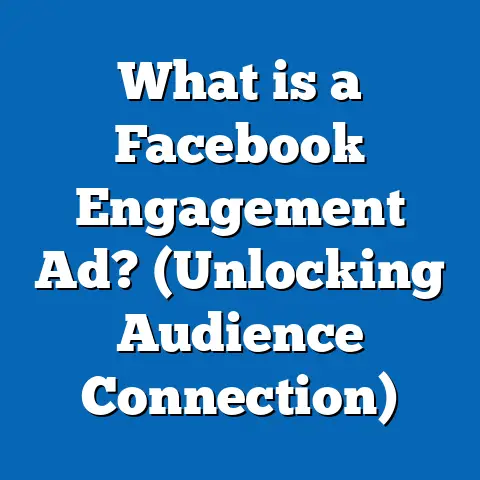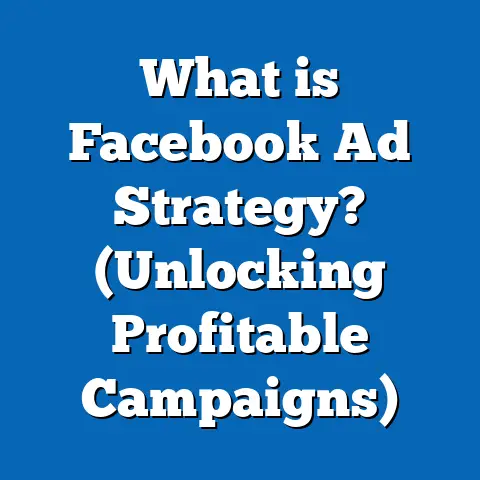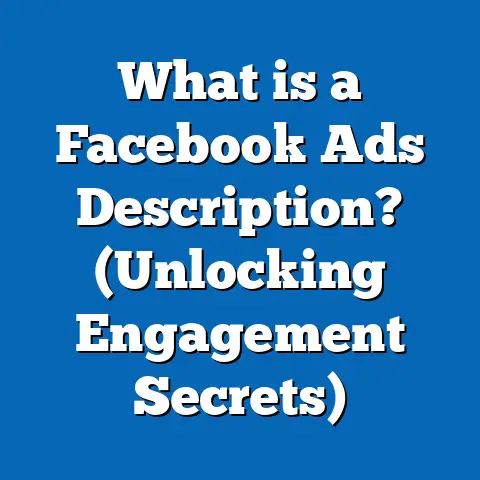What is Facebook Ads Rankings? (Unlocking Ad Success Secrets)
Introduction: Why Safety Matters in Facebook Ads Rankings
In today’s digital marketing landscape, safety extends far beyond the traditional concept of protecting users from harmful content. It also ensures that advertising on platforms like Facebook is conducted within a system that rewards fairness, transparency, and relevance. Facebook Ads Rankings play a pivotal role in maintaining this safety by ensuring ads are not only shown to the right people but also meet the platform’s standards for quality and user experience.
Why is this so important? Because advertisers want their budgets to be spent effectively, while users expect to see ads that are meaningful and non-intrusive. Without a robust ranking system, poor quality or irrelevant ads would dominate feeds, leading to wasted spending and deteriorated user trust.
Facebook’s ad ranking system is designed to strike a balance between monetary bids, ad quality, and user engagement predictions. Understanding this system is essential for marketing professionals and business owners aiming to maximize the impact of their advertising efforts while maintaining compliance with Facebook’s policies. This guide will unpack the complex mechanics behind Facebook Ads Rankings in simple terms, backed by data, real-world examples, and actionable strategies.
Understanding Facebook Ads Rankings: The Basics
What Are Facebook Ads Rankings?
Facebook Ads Rankings are scores assigned to your ads that determine their placement and frequency in users’ feeds. When multiple advertisers compete for the same audience segment or placement, Facebook uses these rankings to decide which ads to show first—or at all.
Unlike traditional auction models that prioritize the highest bidder, Facebook’s system integrates several factors including ad quality and estimated user engagement. This approach benefits both advertisers (who get better ROI) and users (who see relevant content).
Why Does Facebook Use Ad Rankings?
The purpose of this ranking system goes beyond profit maximization:
- Protecting User Experience: Users are more likely to engage with ads that feel natural and relevant rather than intrusive or spammy.
- Ensuring Advertiser Value: By boosting well-targeted, high-quality ads, Facebook helps advertisers get more value for their spend.
- Maintaining Platform Integrity: Ads that violate policies or provide misleading information are penalized or removed.
Key Components of Facebook Ads Ranking
- Bid Amount
This is how much you’re willing to pay for a specific action (click, impression, conversion). While crucial, it’s not the sole factor. - Estimated Action Rates
Facebook predicts how likely users are to take the desired action based on their past behavior and ad relevance. - Ad Quality and Relevance
Measured by user feedback, engagement levels, and content compliance.
The Auction System: How Facebook Determines Which Ads Win
Step-by-Step Auction Process
When an ad opportunity arises—for example, someone scrolling their feed—Facebook runs an auction with all eligible ads targeting that user. The winner is chosen based on a “Total Value” score rather than just the highest bid. Total Value=Bid×Estimated Action Rate×Ad Quality Score\text{Total Value} = \text{Bid} \times \text{Estimated Action Rate} \times \text{Ad Quality Score}
This means:
- You can win with a lower bid if your ad is highly relevant.
- Even the highest bidder can lose if the ad quality is poor or user engagement is unlikely.
Example of Auction Calculation
Suppose two advertisers compete for the same spot:
| Advertiser | Bid ($) | Estimated Action Rate | Ad Quality Score | Total Value |
|---|---|---|---|---|
| A | 2.00 | 0.85 | 0.9 | 1.53 |
| B | 2.50 | 0.50 | 0.7 | 0.875 |
Advertiser A wins despite bidding less because their ad is more relevant and engaging.
Breaking Down Core Ranking Factors
1. Bid Amount — More Than Just Money
Your bid sets the ceiling for how much you’re willing to pay per action or impression. However, Facebook’s system ensures that simply pouring money into bids without improving relevance or quality won’t guarantee success.
Insight: According to Facebook Business data from 2023, advertisers who focus solely on increasing bids without optimizing other factors see diminishing returns beyond a certain point.
2. Estimated Action Rate — Predicting User Behavior
This metric forecasts how likely a user is to interact positively with your ad. It’s calculated by analyzing:
- User past interactions with similar ads.
- User preferences and behaviors.
- The type of desired action (purchase vs. page like).
Example: If you run a video ad targeting users who frequently watch videos in your industry, estimated action rates will be higher.
3. Ad Quality and Relevance — The Heart of Ranking
Facebook assesses:
- User feedback: Negative actions like hiding or reporting ads hurt your score.
- Engagement: Likes, comments, shares improve scores.
- Content appropriateness: Ads with misleading claims or poor visuals get penalized.
Data Point: Advertisers improving ad quality scores from 5 to 8 witness an average CPC reduction of 25% (AdEspresso Report, 2024).
Importance of Ad Relevance Score
What Is It?
Facebook assigns an ad relevance score between 1 and 10 based on predicted engagement and feedback during the campaign life cycle. This score directly influences your ad ranking by affecting estimated action rates and quality score.
How to Improve Your Relevance Score
- Use precise audience targeting to reach interested users.
- Craft compelling creatives that resonate emotionally.
- Continuously test different messages and formats.
- Monitor feedback and pause underperforming ads immediately.
Data-Backed Insights on Facebook Ads Rankings
Key Statistics and Trends
- Cost Efficiency: Ads with relevance scores above 7 cost 20-30% less per conversion than those below 5 (Facebook Business Insights).
- Engagement Boost: Personalized ads increase CTR by up to 35% compared to generic campaigns (Statista, 2023).
- Conversion Impact: Estimated action rate optimization contributes up to a 20% rise in sales conversions (AdEspresso Report).
Case Study: E-commerce Brand Success Story
A fashion e-commerce brand optimized its Facebook campaign by:
- Segmenting audiences based on browsing behavior.
- Testing carousel vs. video ads.
- Refining messaging around seasonal promotions.
Results after 6 months:
- Relevance score increased from 5.5 to 8.7.
- CPC dropped by 28%.
- ROAS (Return On Ad Spend) improved by 35%.
- Overall sales attributed to Facebook ads grew by 22%.
Advanced Concepts Explained Simply
The Role of Facebook Pixel in Ranking
The Facebook Pixel tracks user behavior on your website (page views, purchases). This data feeds back into estimated action rates by signaling which users are likely to convert based on past actions.
Tip: Proper Pixel setup improves ranking by allowing better retargeting and conversion optimization.
Learning Phase: What It Means for Your Ads
When you launch or make significant changes to campaigns, Facebook enters a “learning phase” during which it tests different delivery options to optimize results. Rankings may fluctuate during this time but stabilize as data accumulates.
Practical Strategies to Improve Your Facebook Ads Rankings
Step 1: Audience Optimization
- Use Lookalike Audiences based on your best customers.
- Exclude irrelevant groups to avoid wasted impressions.
- Layer demographic filters with behavior-based targeting.
Step 2: Creative Optimization
- Use high-resolution images or videos tailored for mobile viewing.
- Write clear headlines aligned with user pain points.
- Include strong CTAs like “Shop Now,” “Learn More,” or “Sign Up.”
Step 3: Feedback Monitoring & Adjustment
- Review negative feedback metrics regularly.
- Use Facebook’s Ad Manager reports for deep insights.
- Pause or revise ads with high negative responses immediately.
Step 4: Systematic A/B Testing
Test variables such as:
- Creative types (image vs video vs carousel).
- Headlines and descriptions.
- Offers or discounts.
Track performance over at least one week before deciding winners.
Leveraging Automation and AI for Higher Ranking
Facebook’s AI tools use machine learning algorithms that continuously refine audience targeting and creative delivery based on real-time engagement data.
Automated Rules & Budget Optimization
Set automated rules to:
- Increase budgets on high-performing ads.
- Pause low-performing campaigns.
- Adjust bids dynamically based on time of day or audience segments.
Integration with Multi-Channel Campaigns for Enhanced Effectiveness
Many marketers achieve better results by combining Facebook ads with Instagram Stories and Messenger placements since these platforms share Facebook’s ranking system but engage users differently.
Benefits:
- Increased total value score due to multi-platform engagement.
- Better attribution insights from diverse touchpoints.
Comparison: Facebook Ads Ranking vs Other Platforms
| Feature | Facebook Ads Ranking | Google Ads Quality Score | LinkedIn Ad Relevance Score |
|---|---|---|---|
| Basis | Bid × Expected Action Rate × Quality | Bid × Expected CTR × Landing Page Experience | Engagement × Relevance × Bid |
| User Feedback Impact | High | Medium | Medium |
| Personalization | Very High | High | Medium |
| Common Use Cases | Brand awareness, social engagement | Search intent-driven conversions | B2B networking & lead gen |
| Transparency | Moderate (some opaque elements) | Moderate | Lower |
Facebook’s emphasis on social engagement makes it uniquely suited for consumer brands aiming for emotional connection rather than just intent-based search results as on Google.
Latest Industry Trends Impacting Facebook Ads Rankings (2025)
AI-Powered Targeting & Creative Tools
Facebook now offers AI-driven creative suggestions that predict what kind of visuals or copy will drive better engagement based on past campaign data.
Privacy Changes & Their Impact
With growing restrictions like GDPR and CCPA, personalized targeting faces challenges. Consequently:
- Contextual signals have become more important.
- Conversion modeling fills data gaps caused by limited tracking.
Video Content Dominance
Stats show video ads have a 27% higher average engagement rate than static images (Facebook Internal Data, 2024), contributing positively to quality scores.
Shopping & E-commerce Features
Integrations like Shops and dynamic product ads prioritize items with proven purchase potential in ranking calculations, rewarding advertisers who leverage these features.
Real Life Application Examples: Deep Dive
Example 1: Local Restaurant Campaign Success
A regional restaurant chain used location-based targeting combined with video testimonials from customers. They optimized ad copy emphasizing safety protocols post-pandemic.
Outcome:
- Estimated action rate improved by 40%.
- Reservations increased by 30% via Facebook ads.
Example 2: SaaS Product Launch Campaign
A SaaS company launching new software targeted IT decision-makers using detailed job title filters. They ran A/B tests comparing demo video length variations and CTA buttons.
Results:
- Ad relevance score rose from 6.2 to 8.0 within two months.
- CPC dropped from $3.20 to $2.55.
- Demo requests increased by 22%.
Troubleshooting Common Issues Affecting Your Facebook Ads Ranking
| Issue | Possible Cause | Solution |
|---|---|---|
| Low relevance score | Poor audience targeting | Refine audience segments |
| High cost per click (CPC) | Low estimated action rate | Improve creative appeal |
| Negative user feedback | Misleading or repetitive content | Refresh ad creatives |
| Ads not delivering | Budget too low or high bid competition | Increase budget or bid strategically |
| Learning phase taking too long | Frequent edits during learning phase | Avoid major changes during learning |
Frequently Asked Questions (FAQs)
How often should I check my ad relevance score?
Check weekly during active campaigns to identify trends early and optimize accordingly.
Can I improve ranking without increasing budget?
Yes, focusing on better targeting and creative quality often yields more impact than simply raising budgets.
Does Facebook penalize repeated negative feedback?
Yes, repeated negative feedback lowers your ad quality score drastically affecting rankings.
Summary: Key Takeaways on Facebook Ads Rankings
- Facebook Ads Rankings are determined by bid amount, estimated action rates, and ad quality/relevance.
- Improving your relevance score significantly reduces costs and boosts campaign effectiveness.
- Understanding and optimizing each ranking factor leads to better ad placements and higher ROI.
- Continuous monitoring, testing, and adaptation are critical for sustained success.
- Stay updated on platform changes such as AI tools, privacy regulations, and new ad formats for competitive advantage.
Next Steps for Marketers and Business Owners
- Conduct a full audit of your current campaigns focusing on relevance scores and feedback metrics.
- Implement advanced targeting strategies using custom and lookalike audiences.
- Invest time in creating high-quality creatives optimized for mobile consumption.
- Utilize Facebook Pixel data fully for conversion tracking and retargeting.
- Experiment regularly with A/B testing while minimizing frequent edits during learning phases.
- Leverage multi-channel campaigns across Instagram and Messenger for wider audience reach.
- Keep informed about new platform features like AI creative tools and privacy changes affecting data use.
Mastering Facebook Ads Rankings unlocks not just better performance but also builds safer, more engaging advertising experiences that benefit both marketers and users alike.






